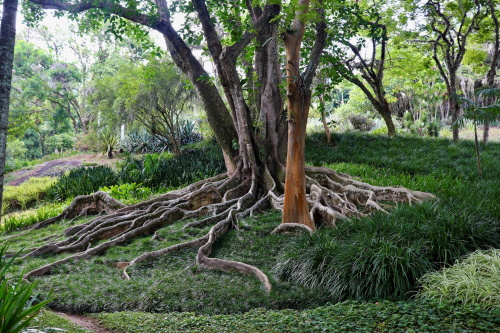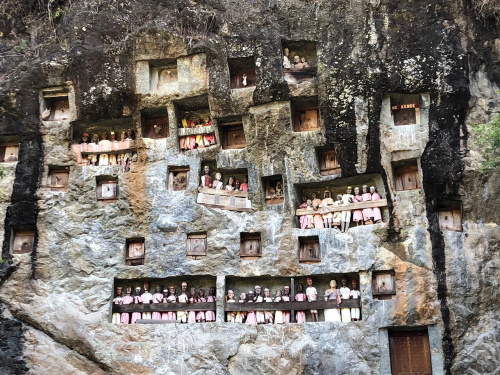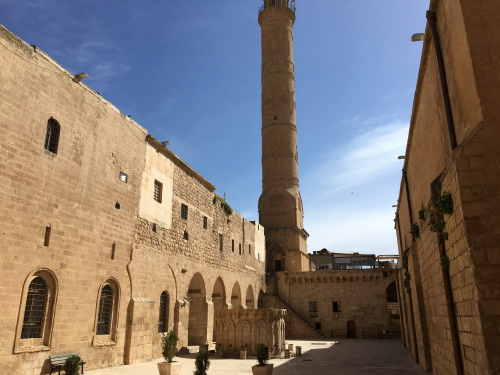Blog WHS website
TWHS project: the wrap-up
On the 31st of January I started the “TWHS project”, to pimp up the individual tentative site pages that have always been limited in content on this website. Now, after almost 4 months, we have reached the finish line (except for a few loose ends). It was a massive job, and especially the many descriptions in French or TWHS with hardly or no description at all were tough to do. But we got through it, thanks to all who participated. Each TWHS at least has a basic page now, including over 40% with a photo as well. I think the addition to the country pages with the markers for "extension" and "already (partly) inscribed" also add value.

Some statistics
- When we started the project, there were 1751 TWHS. Now there are 1772.
- We managed to add photos to 755 of these 1772 (keep them coming!)
- 11 different people sent in texts.
- 13 sent in photos.
- We’ve found additional locations for TWHS, so the maps got a boost from it too.
- We’ve discovered 40 TWHS that are already (partly) inscribed as WHS.
- And 73 TWHS that are proposed as an extension to an existing WHS.
Disappointing Tentative Lists
There were many of them, Lists that disappoint. Some were long, others messy or just lacking clear descriptions:
Belarus stands out for its uninformative descriptions; also the text of the wooden church(es) nomination accidentally contains half of the old text of the Minsk FTWHS.
Brazil has 3 sites already inscribed but still on T list (Atol das rocas, Anavilhanas, Serra do Bocaina). Furthermore lots of old entries and nondescript national parks.
Dominican Republic is a total mess. Montecristi was apparently built in the 23rd century, the City of Azúa de Compostela's description is incomprehensible. Some of the 13(!) TWHS have no description at all. Jacagua's description seems to be written by a carpenter as it consists mostly of measurements.
Egypt’s Tentative List really needs a good clean up from the side of the State Party, many sites are hardly described and there are various double entries. I especially hate the serial sites all across Egypt without obvious links between them.
France: a revision is necessary, as 24 out of its 38 TWHS date from 1996 to 2002. In most cases there is little or very little text on the UNESCO website. And little potential for WHS.
Cyprus as well also holds mostly old entries from 2002, with bad descriptions or none at all. There's a controversial mine at Mathiatis South. Furthermore, 7 of the 11 TWHS actually belong to 1 serial site - the Troodos ophiolite.
Finally, Turkey, India and Iran have huge tentative lists. Probably mostly to please regional authorities or boost tourism in general. After separating the chaff from the wheat however, these 3 countries do have some to possible nominations to bring forward. I have evaluated them in separate write-ups: Turkey, India, Iran.

Tentative Lists with potential
The list with the most potential that I came across myself is the one of Bhutan. Of course Bhutan is still waiting for its first WHS and the major dzongs should be a shoo-in. Furthermore I liked Sakteng Wildlife Sanctuary (remote mixed site, OUV partly based on occurrence of a yeti type being) and the Tamzhing Monastery (niche Buddhism). It also has a fairly high number of natural TWHS.
Indonesia has been underrepresented with 9 WHS. It could be enriched with entries from the T List, I easily found 5+ sites that could make it. These include archipelagos with a large marine component, lots of coral and good for diving (Raja Ampat, possibly Taka Bonerate too). Dutch colonial heritage in Semarang – well-preserved and with a full thumbs up rating from our visitors. Vernacular architecture of various ethnic groups is where the best chances may lie for Indonesia. Tana Toraja is the best known, but I also liked Bawomataluo with its megaliths and Minangkabau society at Nagari Sijunjung. In the cultural landscape category, the nutmeg production on the Banda Islands is of interest.
Finally, a number of Syria’s TWHS are highly rated by our community, for example Apamea and the Hama water wheels.
To those of you who went through some of the lists: what impression (or which site) stands out?
Els - 23 May 2021
Comments
Zos M 23 May 2021
Posted my comments for Philippines tentative list on the forum thread since it's long. Overall, there are lots of potential and still have some gaps not currently proposed.
Colvin 23 May 2021
Here was my remark from the forum on the sites from Oceania:
Now that I have looked over most of the Tentative List for Oceania, some general trends seem to stand out:
Coral Reefs: Many Pacific nations seem to want to get in on this natural wonder, proposing untouched and/or richly biodiverse coral ecosystems. To be fair, some of these tentative sites are in the Coral Triangle, but I don't know how much room there is on the list for incredible coral reefs. Out of the ones I looked through, I was most interested in the nominations for the Marovo-Tetepare Complex (Solomon Islands) and the Marine Protected Areas of American Samoa (USA).
Avian Hotspots: Not surprisingly, there is a high degree of endemism for fauna in Oceania, particularly when it comes to bird life. This continent of islands is also very important for migratory seabirds. At least a dozen tentative sites include references to their avian excellence, but most of the sites also include references to other important natural and cultural features, which may be more of an overall factor for getting them inscribed. Sites like New Zealand's Kermadec Islands and Marine reserve or Whakarua Moutere (North East Islands) might have opportunities for inscription if they were to improve their packages.
Mixed Sites: Perhaps pulling from the success of Papahânaumokuâkea (USA) and Rock Islands Southern Lagoon (Palau), several countries have proposed mixed sites to take advantage of the natural wonders and biodiversity as well as the cultures that live in and rely on these environments. Some of the proposed tentative sites, such as Les Iles Marquises (France) and Fagaloa Bay-Uafato Tiavea Conservation Zone (Samoa), seem promising, but others, like the Northern Marshall Islands Atolls (Marshall Islands), need more work.
Looking over the list, the unique nominations that interest me most for cultural sites are the Yapese Disk Money Regional Sites (Micronesia and Palau) and the Nowon and Votwos of Ureparapara (Vanuatu). For the natural sites, I'm intrigued by Yaduataba Crested Iguana Sanctuary (Fiji) and Marianas Trench Marine National Monument (USA).
I'd also love to see some more transnational sites put forward to highlight the region's rich heritage, from the Lapita culture to more recent Polynesian cultures, sailing across the Pacific.
Colvin 23 May 2021
This project was a lot of fun! I wrote up a review of the Tentative Lists of Oceania in the forum, but I may copy that over in a second comment.
I worked mostly at the end of the alphabet, and generally found at least one or two sites in each country there that impressed me, such as the Natetale Cluster of Dzimbabwes (Zimbabwe); the Barotse Cultural Landscape (Zambia); Hacienda Chuao (Venezuela); and Ba Be-Na Hang Natural Heritage Area (Vietnam).
I was most impressed with the list from Yemen, though, which includes such cultural sites as the Archaeological Site of Marib, the Historic city of Saada, and Jibla and its surroundings; and the natural Hawf Area, a fog oasis that may still house the endangered Arabian leopard.
Like others have mentioned, some of the site proposals on the TWHS list were incomplete or bad; thankfully, not all were Tet el Bad (Palau).
Frédéric M 23 May 2021
Yeah, this project was really interesting.
Mexico has a long list filled with historical towns and prehispanic archeological sites. Some natural TWHS seem to have potential: Aire de protection de la flore et de la faune Cuatrociénegas, Los Petenes-Ría Celestún and Ring of cenotes of Chicxulub Crater, Yucatan. Peru has some weird shamanic entries, but also a lot of potential: Archaeological Complex of Toro Muerto, Chachapoyas sites of the Utcubamba Valley, Chankillo Astronomical Complex, Guano Islands, Islets, and Capes National Reserve System form Peru (RNSIIPG), Lake Titicaca, Landscape Reserve Sub Cuenca del Cotahuasi, Sierra del Divisor National Park.
African countries french T-lists I went through were not great. Mainly cultural propertries with either few tangible remains or only local significance, often with poor description of the OUV. Some slave trad sites. And natural sites that didn't seem to stand among the already inscribed savannah and tropical forest sites of Africa. Some interesting candidates: Reserve de Biosphere de l'Archipel des Bijagos (Guinea Bissau), Les forets sèches de l'Andrefana (Madagascar), NOSYnakà (Sahamalaza, Nosy Hara, Nosy Tanikely, Lokobe, Ambodivahibe, Ankarea, Ankivonjy) (Madagascar).
Hubert 23 May 2021
It was really a nice project.
Not only the short or non-existent texts made it difficult, the long but meaningless descriptions were also annoying.
The French list needs to be revised, but Spain also has a weird list. Unesco should insist that the state parties renew their list regularly: just delete everything older than 20 years. Anything that should remain must be resubmitted.
The biggest surprise of my contributions was Pakistan. A long list too, but with potential. Many archaeological sites where I don't know how much is preserved.
But some more recent sites look impressive:
Tomb of Jahangir, Wazir Khan Mosque, Chaukhandi tombs, or Derawar Fort.
And the Central Karakorum National Park.
Kyle Magnuson 23 May 2021
North Korea's 21 year-old Tentative List is filled with brief descriptions that lean heavily on hyperbole and flowery language.
Mt. Myohang and the Relics in and Around the Mountain - "Mt. Myohyang has been called "the mountain of curiosity, beauty and sweet smell".
Historical Relics of Pyongyang - "Pyongyang, the cradle of the Korean nation, has a great number of sites of all the primitive ages . . . The city has been the capital of Ancient Korea for nearly 3000 years . . ."
Mt. Kumgang and the Historical Relics in and Around the Mountain - "Mt. Kumgang is a strikingly beautiful mountain with numerous peaks and curious rocks amounting to some 1,2000, waterfalls and pools formed by crystal-like clear waters . . ."
Caves in the Kujang Area - "The cave is characterized by its soft, beautiful and gorgeous appearance."
Mt. Chilbo - "And the beautiful scenery of the curious rocks in Sea Chilbo, stretched out for 40 kilometers from Musudan to Orangdan, throw the visitors in a trance."
